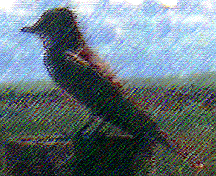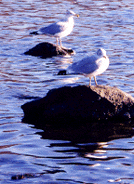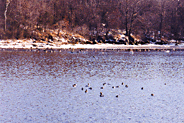|
|
|||||||
|
January 17, 1999 |
|
hundreds of canvasbacks, hardly any widgeons |
|||||
|
|
|
|
|||||
Copyright © 1998, Janet I. Egan |
|
The first thing you notice are the swans. They're big. There are a lot of them. They're aggressive. Many locals will tell you "there's nothin' there but the swans". I've counted up to 90 swans on a Sunday afternoon but I've only ever noticed two pairs that actually produced and raised cygnets. The males will clobber anything they think threatens the cygnets. The mute swan is definitely the dominant life form at the cove, but certainly not the only one. The second thing you notice are the gulls. Ring billed
gulls, herring gulls, great black backed gulls, Bonaparte's
gulls, and even common black headed gulls are regular
visitors. I've found up to 5 The star attraction though is the amazing variety of
wintering ducks: canvasbacks, widgeons, hooded mergansers,
buffleheads, mallards, black ducks, Winter is the prime duck time. Winter is the time of the most species diversity. Winter is the season the cove shines. Summer is a whole 'nother subject I'll save for a different entry. So, what is this place?Watchemocket Cove is a tidal basin off the Providence River, to the east of the East Bay Bike Path. The Corps of Engineers described it as suburban: Land use in the immediate vicinity of the site includes two roads carrying moderate amounts of traffic, the Metacomet Golf Club, and a residential area. The East Bay Bicycle Path runs across the mouth of the cove, on an old rail bed. In general, this area is suburban in nature. Umm, neither my description so far nor the above excerpt from the Corps' description really convey that this is a tiny gem surrounded not just by bike path and country club but also the site of a sewage pumping station. With all that though it's still has aspects of a wild place with mud flats and salt marsh (both species of Spartina and the ever present every multiplying Phragmites). Across the Providence River you can see the tank farm, and sometimes see the tankers coming into the harbor to unload. You're definitely not out in the pristine wilderness. But the ducks don't seem to know that. Today was a glorious day weatherwise and people and waterfowl took full advantage of it. I have never seen so many birders and breaders at the cove on a single afternoon as I did today. Haven't seen this many canvasbacks either. Tons of 'em. I lost count at 280. I know there were more than that. The list for today: 280 canvasbacks I have no idea where the other 100 widgeons were today, but everybody, even the canvasbacks, was flying around a lot. The rest of the widgeons were probably at one of the two smaller coves to the south (Nancy calls them exquisite cove and long cove but as far as I know they have no names). The two widgeons I did see were trailing around after the hooded mergansers as usual. |
|||||

 The
thing about Watchemocket Cove is it teems with life. It's
darn near impossible to capture it in a single photograph or
even a series of photos. It's just too fluid, too alive, too
immediate, and too complex.
The
thing about Watchemocket Cove is it teems with life. It's
darn near impossible to capture it in a single photograph or
even a series of photos. It's just too fluid, too alive, too
immediate, and too complex. common black headed gulls, which aren't common at all, at
low tide - usually with a flock of Bonaparte's gulls but
sometimes just mixed in with the ring bills. Today they were
all flying around so much I couldn't really identify any
rarities. Vast clouds of gulls just circled around both
sides of the parkway, touching down either on the mud flats
exposed by the low tide or on the small parking area next to
the East Providence department of water pollution
building.
common black headed gulls, which aren't common at all, at
low tide - usually with a flock of Bonaparte's gulls but
sometimes just mixed in with the ring bills. Today they were
all flying around so much I couldn't really identify any
rarities. Vast clouds of gulls just circled around both
sides of the parkway, touching down either on the mud flats
exposed by the low tide or on the small parking area next to
the East Providence department of water pollution
building. scaup,
goldeneye, you name it. It's a great place to observe the
interactions among species and to compare behaviors of
different species. Watching the buffleheads and the hooded
mergansers feeding in close proximity led me to notice their
different diving patterns: how long they stay under, whether
they all dive at once or one at a time, how deep they go,
and so on. And I've noticed that some widgeons follow flocks
of hooded mergansers and seem to feed on what the mergansers
stir up during their dives. Some widgeons also follow
canvasbacks. I've noticed a pair that seem to have detached
from the main widgeon flock and cast their lot with the
diving ducks. At least I think it's the same pair every time
I've seen it. I'd love to band them or something and study
them with a little more scientific rigor. This place is
practically an open air duck behavior lab.
scaup,
goldeneye, you name it. It's a great place to observe the
interactions among species and to compare behaviors of
different species. Watching the buffleheads and the hooded
mergansers feeding in close proximity led me to notice their
different diving patterns: how long they stay under, whether
they all dive at once or one at a time, how deep they go,
and so on. And I've noticed that some widgeons follow flocks
of hooded mergansers and seem to feed on what the mergansers
stir up during their dives. Some widgeons also follow
canvasbacks. I've noticed a pair that seem to have detached
from the main widgeon flock and cast their lot with the
diving ducks. At least I think it's the same pair every time
I've seen it. I'd love to band them or something and study
them with a little more scientific rigor. This place is
practically an open air duck behavior lab.